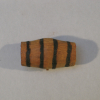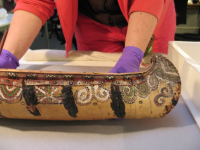canoe, model
canoe, model
canoe, model




















































A model of a bark canoe, with two wax dolls and various items. Likely of Anishinaabe origin, and produced in a convent between 1750-1790. Part of the Augustus Henry Lane Fox Pitt Rivers founding collection.
Likely produced by an Abenaki or Maliseet convent in Quebec city, with the nuns dressing the dolls and the Aboriginal people likely making the canoe (RP). The canoe appears to be of an Anishinaabe style. Also, the presence of man boards at the canoe's bow and stern is typical of those made by communities in the Great Lakes region (RP).
LP noted that, because there were so many different Aboriginal groups around Quebec City during this period, any of whom could have made parts or all of this item, it is the sort of object which "really challenges the whole concept of 'tribal' and brings it firmly into the historical realm of refugees and hybridity."
Notes by GES Turner, in the back of the accession book, read "Algonkin Indians probably River Desert Band (modern Maniwaki Reserve)." However, this reserve did not come into existence before 1851.
Pitt Rivers Object catalogue and observations made by the GRASAC research team.
Read More About This Relative
Canoe: birch bark, unidentified wood for spears and ribs, seams waterproofed with pitch mixed with charcoal, red paint or ochre; spruceroot for strapping; wooden centremass with a sail rolled up. Contents of Canoe: a miniature wampum belt made of black and white imitation wampum beads; a miniature wooden toboggan with two painted wooden panels and a beaded silk binding strap; a wooden long gun; a furled sail; two miniature snowshoes made of bent wood, thread, with grey tufts or grey wool; a miniature wood-carved keg, bottle, powder horn and axe (bits and pieces of which are broken off, kept in plastic bags). Two Dolls -- Doll A: Her body is a wax doll, commercially-produced in Europe, now badly deformed from sun damage. She is wearing a wrap-around linen skirt that imitates broad cloth or stroud bound with white silk ribbon near its bottom edge, and a very long linen shirt with a cuffed short gown over it. The short gown is made with striped silk, belted with linen thread. Her white leggings are made of linen, with one side of the flaps edged in blue and the other in red. Her high cuffed moccasins are made of untanned hide and are painted to suggest a centre seam quill or moose hair design. For jewelry, she is wearing a silver crescent-shaped gorget on a string of multi-coloured and variously sized pony and seed beads, a multiple strand beaded bracelet on one arm, and a silver bracelet on the other arm. A decorative brooch may have been on the centre front of her chest. There are various beads stuck into her head, and large red circles are painted on her cheeks. Doll B: Like Doll A, she is made of wax. One cheek painted is red, and the other black. There is also black paint on her forehead. She is dressed in a long linen shirt with a blanket tied at waist and folded over, with a blue silk and wide ribbon band. Her blue legging flaps are bound with blue and white ribbon, and she is wearing untanned deer hide moccasins with a painted-on centre seam, tied around the ankle and flipped up. Its hood is of an East Coast Algonkian or Micmac style, made out of red woolen cloth, edged with silk, with blue linen tape running up the centre seam, decorated with size 20 multicoloured tubular beads. For jewelry, he or she is wearing earrings, a circular brooch which holds its shirt closed, multi-coloured beaded bracelets, a silver arm band. She is also wearing a knife sheath of untanned hide on woven thread, with a strap painted down the back to imitate quill work.
Moccasins have saw-tooth edged flaps.
Clothing has been sewn. Beaded bracelets decorate the dolls.
Other items have been carved and painted.
See above for additional construction details.
The hood of Doll B is decorated with a black and white four-pointed cross motif on its edging.
RP drew attention to a figure at both ends of the canoe, with a red head. She explained that ethnographers have written about such figures in canoes, translating their name as "man board" which Great Lakes people would paint on the inside of their canoes to represent its spirit. RP noted this as further evidence in support of the idea that Aboriginal people made this item, as she could not imagine a nun painting such an element onto the model canoe.
Based upon the detailed workmanship of many of the items, RP believes they were made by both Aboriginal people around Quebec City and nuns, who likely dressed the dolls.
Pitt Rivers Museum Object Catalogue.
Provenance
This model canoe was part of the Augustus Henry Lane Fox Pitt Rivers Collection, transferred from the South Kensington Museum in 1884. It was delivered to the Bethnal Green (South Kensington) Museum, later known as the Victoria and Albert Museum, in September 1876.
A note in the Pitt Rivers Museum catalogue record states that elements of this set correspond closely with specimens in the Speyer Collection (Cat. Nos. 105, 106, 107, 109) as to suggest a common maker. See V. Benndorf and Speyer, 1968: Indianer Nordamerikas 1760-1860, Aus Der Sammlung Speyer (Deutshces Ledermuseum, Offenbach a.M.), pp. 74-5, pl. 41.
It is presumably this item that is referred to, as a comparable example to that illustrated, on page 25 and in note 19 on page 33 of "A Casket of Savage Curiosities": Eighteenth-Century Objects from North-Eastern North America in the Farquharson Collection', by Ruth B. Phillips and Dale Idiens, Journal of the History Collections, Vol. VI, no.1 (1994), pp. 21-33.
About This GRASAC Record
This record was created as part of a Great Lakes Research Alliance for the Study of Aboriginal Arts and Cultures (GRASAC) research trip to the Pitt Rivers Museum and British Museum, December 8-22 2007, funded by a grant from the International Opportunities fund of the Social Sciences and Humanities Research Council (SSHRC).
researchers present: Heidi Bohaker (HB), Al Corbiere (AC), Stacey Loyer (SL), Janis Monture (JM), Laura Peers (LP), Ruth Phillips (RP), Anne De Stecher (AS), Cory Willmott (CW).













Stylistic features.
 Knowledge Sharing Platform
Knowledge Sharing Platform



















































